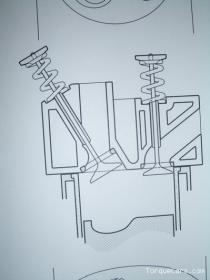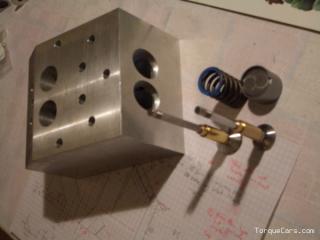Hi:
Under "How do you control an ECU?", I briefly explained what I'm aiming at.
It's all very difficult because I find I'm working alone. Therefore, if anyone wants to help in any way, please get intouch. I'm near Sheffield but distance isn't an insuperable problem.
Many years ago, I was one of those amateurs who built racing cars, and looking back, what we did, and even what we failed to do, gives hope for mankind. Then, everything was more flexible. I could drive in the early hours and have a CVC shaft made up by breakfast time at Hardy-Spicer in Brum, and have it fitted by the evening, with my day's work fitted in between. Bit harder now.
In the back of my mind, I wondered why the two-stroke was so neglected.
I now know why (control of combustion needed the advent of sophisticated high pressure diesel systems) but many of these problems/objections can now be overcome, so it should have a place. But, because of its smoke and particles, it is outlawed for land and sea use.
The other problem is, any poppet valve is used, the camshaft rate is twice that on a four stroke, meaning, say, running at 3000 rpm implies a pretty carefully developed valve train.
But its use for a propeller driven aero engine is ideal.
Do we need such engines? Answer, emphatically yes. Piston enginers are cheap compared to jets, and a propeller is reliable, with certain provisos.
Jet engines are incredibly costly, and simply hitting a flying bird may effectively write off the whole plane by cost.
Initial considerations
Propellers generate thrust according to diameter and revs. But if you increase either revs or diameter, you increase the tip speed of the blades. As they approach sonic levels, bad vibration occurs. So there is a fundamental limit. Whatever you do, you are limited.
That means restricting propeller revs, effectively.
You can get more absolute power by running the engine faster and using a reduction gearbox. Two probs: g/boxes are either notoriously unreliable, or heavy. Both bad. (I don't know why a simple epicyclic g/box wouldn't be OK. I think it would be). But the prop is like a huge flywheel and the g/box between it and the engine, and may suffer.
It would good to have low engine speeds with direct drive. But to get the required power, you need high piston pressure. The two stroke gives that each 360o rather than each 720o. Double the power.
What are we after?
Let's say we chose (about) 2500 rpm, let's say 2400 rpm for simplicity.
That's a nice prop speed to avoid sonic vibration, given typical prop sizes..
Now let's look at what flies at present.
The beautiful Diamond twin aircraft has two A-series Mercedes turbo-diesel four-stroke engines. They weigh about 140 kg and yield about 130 bhp. And they are far too underpowered. So let's say we aim for 240 bhp. Let's think ambitiously of a 3.5 L, 8 cylinder engine (there are reasons for this).
Each cylinder volume is ~450 cc, giving 30 bhp.
Mean Piston Pressure is Power/(Revs*Vol) because Vol is area (which dermines Force) * Stroke (which takes us to Work done).
So, in Watts, Revs per second, Pascals and Metres,
we get
Mean Pressure=1250000 Pa or 12.5 bar.
So that's what we are after with any model that is going to be scaleable to our purpose.
I need to build a single cylinder two- stroke turbo diesel that will provide 12.5 bar at 2500 rpm.
I'll post again in weeks to come, detailing progress.
If anyone wants to get involved in any way, I'll be glad of help, as long as it's not a time waste.
Malc9141
(malcolm351@btinternet.com)
Under "How do you control an ECU?", I briefly explained what I'm aiming at.
It's all very difficult because I find I'm working alone. Therefore, if anyone wants to help in any way, please get intouch. I'm near Sheffield but distance isn't an insuperable problem.
Many years ago, I was one of those amateurs who built racing cars, and looking back, what we did, and even what we failed to do, gives hope for mankind. Then, everything was more flexible. I could drive in the early hours and have a CVC shaft made up by breakfast time at Hardy-Spicer in Brum, and have it fitted by the evening, with my day's work fitted in between. Bit harder now.
In the back of my mind, I wondered why the two-stroke was so neglected.
I now know why (control of combustion needed the advent of sophisticated high pressure diesel systems) but many of these problems/objections can now be overcome, so it should have a place. But, because of its smoke and particles, it is outlawed for land and sea use.
The other problem is, any poppet valve is used, the camshaft rate is twice that on a four stroke, meaning, say, running at 3000 rpm implies a pretty carefully developed valve train.
But its use for a propeller driven aero engine is ideal.
Do we need such engines? Answer, emphatically yes. Piston enginers are cheap compared to jets, and a propeller is reliable, with certain provisos.
Jet engines are incredibly costly, and simply hitting a flying bird may effectively write off the whole plane by cost.
Initial considerations
Propellers generate thrust according to diameter and revs. But if you increase either revs or diameter, you increase the tip speed of the blades. As they approach sonic levels, bad vibration occurs. So there is a fundamental limit. Whatever you do, you are limited.
That means restricting propeller revs, effectively.
You can get more absolute power by running the engine faster and using a reduction gearbox. Two probs: g/boxes are either notoriously unreliable, or heavy. Both bad. (I don't know why a simple epicyclic g/box wouldn't be OK. I think it would be). But the prop is like a huge flywheel and the g/box between it and the engine, and may suffer.
It would good to have low engine speeds with direct drive. But to get the required power, you need high piston pressure. The two stroke gives that each 360o rather than each 720o. Double the power.
What are we after?
Let's say we chose (about) 2500 rpm, let's say 2400 rpm for simplicity.
That's a nice prop speed to avoid sonic vibration, given typical prop sizes..
Now let's look at what flies at present.
The beautiful Diamond twin aircraft has two A-series Mercedes turbo-diesel four-stroke engines. They weigh about 140 kg and yield about 130 bhp. And they are far too underpowered. So let's say we aim for 240 bhp. Let's think ambitiously of a 3.5 L, 8 cylinder engine (there are reasons for this).
Each cylinder volume is ~450 cc, giving 30 bhp.
Mean Piston Pressure is Power/(Revs*Vol) because Vol is area (which dermines Force) * Stroke (which takes us to Work done).
So, in Watts, Revs per second, Pascals and Metres,
we get
Mean Pressure=1250000 Pa or 12.5 bar.
So that's what we are after with any model that is going to be scaleable to our purpose.
I need to build a single cylinder two- stroke turbo diesel that will provide 12.5 bar at 2500 rpm.
I'll post again in weeks to come, detailing progress.
If anyone wants to get involved in any way, I'll be glad of help, as long as it's not a time waste.
Malc9141
(malcolm351@btinternet.com)








